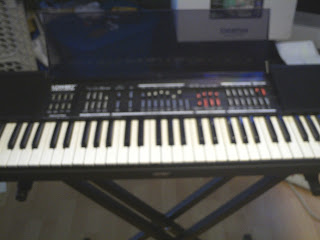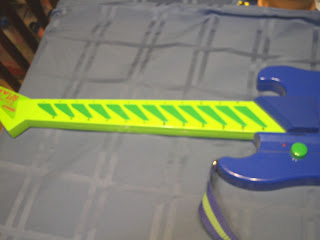I came across this gem when I was searching old Casio keyboards and it appears to be an attempt from one of the many organ companies to break into the home keyboard market, much like the Kimball Voyager and Challenger keyboards, the Baldwin Explorer and Discover keyboards, and the Wurlitzer P100. Lowrey had decided to rebrand mid- to high-range keyboards manufactured by the Victor Company of Japan, Ltd., commonly known by its 3-letter logo - JVC. The V-120 is the highest analog keyboard c. 1984 of the series before they started utilizing digital sounds, as well as some other interesting features that I will mention briefly in this review. The only apparent difference between the V-120 and the KB-700 is the lack of Stereo Pan potentiometers located above the stereo mixer for all the features, but this absence is a minor issue. It seems apparent that this keyboard was designed for multiple markets because of the presence of a voltage selector on the back that allows for change depending on what region you are in.
Build
This keyboard definitely feels more solid than a cheap Casio. The buttons are unique in appearance but definitely feel as if they can withstand the test of time. The sliders also feel good making smooth transitions in volume and tempo easy to perform. The speakers do not rattle the case at the highest volume (although I do believe quality is lost when pushed to the max). The foot pedal does feel a bit on the cheap side and looks more like it belongs to a sewing machine.
Cosmetics
This keyboard is simple but attractive, with each grouping of buttons and sliders matching in color and with the features easy to read. An added bonus to the cosmetics are the plastic covering for the buttons that serves a dual purpose - it acts as a dust cover, which can be very helpful in maintaining the buttons and sliders, and it also can be utilized as a sheet music holder.
Sound
The sound is 100% analog and definitely has a nice warmth to it, more so than other home analog home keyboards from that era, like the Bontempi X-451, which has a nice analog sound but definitely not as rounded. The rhythms are pure synthetic bliss and offer a nice change from the various other brands out there, and like the presets, the rhythms also present a warmer sound.
While the rhythms are nice, from the few recordings I have heard of the JVC KB-700, it sounds as if they differ slightly. I am not sure if that is the case. The same goes for the auto accompaniment. From what I had read, Lowrey had kind of revolutionized automatic accompaniment and that by the time this keyboard features like this became common place on home keyboards. It is possible that Lowrey had decided to use their own tried-and-true rhythms as opposed to ones developed by JVC.
Features
While still a preset home keyboard from the early Eighties, this levels of variation this keyboard provides is worth it if you can find this keyboard relatively inexpensive (which can sometimes be a problem being that it is not as well known or mass produced as the various Casios out there). In addition to the standard tones, rhythms, and accompaniments this keyboard offers, the mixers provide for greater control on overall sound. There are also some effects that can be used to give the 12 voices some extra sound, such as foot switch effects (sustain, glide, & break), chorus, tremolo, and Lowrey's proprietary AOC, or Automatic Orchestra Control (or Automatic Organ Computer), which takes the chord played, inverts the notes, and then adds them to the melody note being played on the upper part of the keyboard. These features all have sliders to change degree of effect.
The same goes for the auto-accompaniment, with sliders offering degrees of variation for features like the bass or arpeggiator. For example, changing the settings for bass variation would play 3 bars of one pattern and than one bar of another.
Another interesting feature is using the mic in to use the keyboards effects and apply them to your own vocals, guitar, or even another keyboard or synthesizer.
While not part of the keyboard, the hard case is nice. It is awkward to open, being that you must stand the case upright and push the buttons outward. The case then opens with the keyboard standing on its back. The keyboard doesn't come flopping out though - it is held in by three elastic straps with buttons. My only complaints about these straps is that two of them extend over keys and keep them depressed while in storage. I feel that this may cause unnecessary wear on only a couple of keys.
Overall
As mentioned above, while this keyboard was top of the Lowrey Micro Genie analog line, future versions moved in a more digital direction and featured an interesting feature - a KE-10 digital composer cartridge, which basically acts like the composer computers found on the early keyboards, but can be removed and swapped with other composer cartridges. It is safe to say that the keyboards were designed this way because JVC intended on created somewhat modular sequencing or synthesis capabilities in future models. They also had add-ons like a strum board that would allow the keyboard to be played like a guitar. While those features are interesting, the later models, like the KB-800 or KB-808 lack the warmth of the V-120's analog tones and rhythms. Had those features been available in conjunction with this keyboard, the V-120 would be a must-have in any musician's collection.
Minus the features of later versions, this keyboard still offers some great warm presets from a bygone era. These keyboards are oddities - they feature elements popularized by organ companies (like automatic chords and accompaniments) and presented them in a different format for home use. This keyboard may be more so an oddity since it is just a rebranded JVC but the features are nonetheless enjoyable and provide enough flexibility. I wouldn't consider this to be a flagship synthesizer but these older instruments are great for accents and rhythms. While there are many virtual instruments, plug-ins, or sound modules out there that can provide similar sounds while occupying far less space, there is something about these old keyboards that provide for a more intimate playing experience.
Gallery
Build
This keyboard definitely feels more solid than a cheap Casio. The buttons are unique in appearance but definitely feel as if they can withstand the test of time. The sliders also feel good making smooth transitions in volume and tempo easy to perform. The speakers do not rattle the case at the highest volume (although I do believe quality is lost when pushed to the max). The foot pedal does feel a bit on the cheap side and looks more like it belongs to a sewing machine.
Cosmetics
This keyboard is simple but attractive, with each grouping of buttons and sliders matching in color and with the features easy to read. An added bonus to the cosmetics are the plastic covering for the buttons that serves a dual purpose - it acts as a dust cover, which can be very helpful in maintaining the buttons and sliders, and it also can be utilized as a sheet music holder.
Sound
The sound is 100% analog and definitely has a nice warmth to it, more so than other home analog home keyboards from that era, like the Bontempi X-451, which has a nice analog sound but definitely not as rounded. The rhythms are pure synthetic bliss and offer a nice change from the various other brands out there, and like the presets, the rhythms also present a warmer sound.
While the rhythms are nice, from the few recordings I have heard of the JVC KB-700, it sounds as if they differ slightly. I am not sure if that is the case. The same goes for the auto accompaniment. From what I had read, Lowrey had kind of revolutionized automatic accompaniment and that by the time this keyboard features like this became common place on home keyboards. It is possible that Lowrey had decided to use their own tried-and-true rhythms as opposed to ones developed by JVC.
Features
While still a preset home keyboard from the early Eighties, this levels of variation this keyboard provides is worth it if you can find this keyboard relatively inexpensive (which can sometimes be a problem being that it is not as well known or mass produced as the various Casios out there). In addition to the standard tones, rhythms, and accompaniments this keyboard offers, the mixers provide for greater control on overall sound. There are also some effects that can be used to give the 12 voices some extra sound, such as foot switch effects (sustain, glide, & break), chorus, tremolo, and Lowrey's proprietary AOC, or Automatic Orchestra Control (or Automatic Organ Computer), which takes the chord played, inverts the notes, and then adds them to the melody note being played on the upper part of the keyboard. These features all have sliders to change degree of effect.
The same goes for the auto-accompaniment, with sliders offering degrees of variation for features like the bass or arpeggiator. For example, changing the settings for bass variation would play 3 bars of one pattern and than one bar of another.
Another interesting feature is using the mic in to use the keyboards effects and apply them to your own vocals, guitar, or even another keyboard or synthesizer.
While not part of the keyboard, the hard case is nice. It is awkward to open, being that you must stand the case upright and push the buttons outward. The case then opens with the keyboard standing on its back. The keyboard doesn't come flopping out though - it is held in by three elastic straps with buttons. My only complaints about these straps is that two of them extend over keys and keep them depressed while in storage. I feel that this may cause unnecessary wear on only a couple of keys.
Overall
As mentioned above, while this keyboard was top of the Lowrey Micro Genie analog line, future versions moved in a more digital direction and featured an interesting feature - a KE-10 digital composer cartridge, which basically acts like the composer computers found on the early keyboards, but can be removed and swapped with other composer cartridges. It is safe to say that the keyboards were designed this way because JVC intended on created somewhat modular sequencing or synthesis capabilities in future models. They also had add-ons like a strum board that would allow the keyboard to be played like a guitar. While those features are interesting, the later models, like the KB-800 or KB-808 lack the warmth of the V-120's analog tones and rhythms. Had those features been available in conjunction with this keyboard, the V-120 would be a must-have in any musician's collection.
Minus the features of later versions, this keyboard still offers some great warm presets from a bygone era. These keyboards are oddities - they feature elements popularized by organ companies (like automatic chords and accompaniments) and presented them in a different format for home use. This keyboard may be more so an oddity since it is just a rebranded JVC but the features are nonetheless enjoyable and provide enough flexibility. I wouldn't consider this to be a flagship synthesizer but these older instruments are great for accents and rhythms. While there are many virtual instruments, plug-ins, or sound modules out there that can provide similar sounds while occupying far less space, there is something about these old keyboards that provide for a more intimate playing experience.
Gallery































